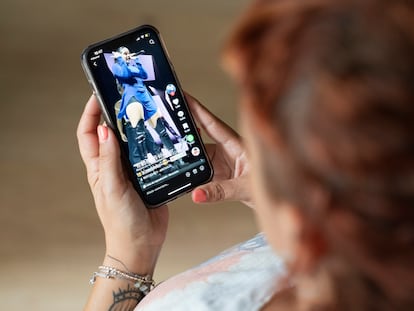Bored and alone, underprivileged minors turn to screens for escapism
Left unsupervised during the day, young people from low-income families often use digital devices as a way to escape their reality


Facundo was not a difficult boy. He did not cause problems at home or at school. According to his mother, Ninfa Alarcón, he had always been “very responsible, very well-behaved.” However, when he was 15 years old, his counselor called Alarcón to inform her that he was not going to class and, when he did, he arrived after noon. That is when she realized that her son had become addicted to video games. She was away from home almost all day due to her work, and Facundo, left alone, “played for hours and hours,” she says. The teenager got to a point where he was spending more than 12 hours in front of the computer screen.
This is not an isolated case. Although the WHO advises not to exceed two hours a day in front of a screen, many young people do it for at least three daily hours; five on the weekends. This excessive use is related to several factors, one of them being the economic situation of families: according to a report by the Gasol Foundation, almost 70% of minors who belong to a low-income environment in Spain exceeded the WHO recommendations, 9% more than those who belonged to the highest income families.
Facundo, who is now 18, and his mother, 47, arrived in Segovia, Spain, from Peru, their homeland, in 2018. Their financial hardship motivated them to ask the charity organization Cáritas for help. Their first years there they did not have internet at home, so the boy used to go to the municipal library, where he could use the computers for up to four hours. When Ninfa was able to hire the service at home, the situation got worse. Facundo could use it almost without interruption. She would leave home at 5.00am and not return until late in the afternoon, so her son could stay playing on the computer unsupervised. When she found out about the boy’s addiction, Alarcón gave him the benefit of the doubt — until the school called again. “I also couldn’t control it because my work situation didn’t allow it; I couldn’t make money if I stayed at home.”
Last February, Cáritas published a report on the excessive use of electronic devices (more than six hours a day). In the lower-income families interviewed, the risk of addiction was almost 21%. More than one in five. Carmen García, who is in charge of the Childhood and Family programs of Cáritas Spain, emphasizes loneliness, the lack of alternative entertainment, the lack of motivation and the desire to escape from their own reality as triggering factors.
The long time that young people from low-income families spend alone is a key determinant, explain Genís Segundo from the Gasol Foundation and Carmen García from Cáritas. Furthermore, they may not have many alternative leisure options if there are no parks close to home, or if the ones that exist are neglected or unsafe, explains García, and in many cases parents cannot afford to pay for extracurricular activities for their children, which was the case with Ninfa and Facundo.
To deal with her son’s problem, Alarcón asked Cáritas for help and they began to work with one of their psychologists. From that moment on, she had to take the router and all the computer cables in her purse to prevent him from using it. “Still, he found cables around the house that he could use. He was like a drug or alcohol addict,” laments the mother.
Addiction and family conflicts
Although they do not fit the profile of a low-income family, Marta and Daniel, a mother and son from Gijon, Spain (their names have been changed to protect their identities) also received help from Cáritas for a similar situation. When he started elementary school at the age of six, the school provided Daniel with a computer to study, which he also used to play. By the time he was 9, it had become a problem. “The time to take the computer away from him or to tell him to turn it off was always a struggle. He broke a lot of things,” recalls his mother.
The boy spent between 10 and 12 hours a day playing: “I hardly slept at all.” The situation worsened until one day, when he was 11, Daniel pushed and kicked his mother. She had to call the police. After the confrontation, they began to work with the Technical Intervention Team for Family Support from the municipal social services. Through them, Daniel began to go to a Cáritas day center, where he spent the afternoons while Marta was at work. There he did his homework and, in addition, they helped him work through his addiction and the family conflicts. Nevertheless, Marta had to quit her job, because she spent many hours away from home.
Nowadays, Daniel practically does not play video games; he replaced them with social media, and has greatly reduced his screen time. His parents installed a parental control service on his cell phone that limits his internet use to a maximum of four hours a day. Even so, Daniel estimates that, on weekdays, he spends four to six hours a day in front of screens (TV and phone); the figure rises to seven or eight hours on the weekend, which is when he can use his phone freely.
Carmen García, from Cáritas Spain, explains that video games offer an additional benefit to minors from low-income environments: they let them be whoever they want to be. “They allow them to get away from their reality, which is quite difficult, and escape from it,” she says. García also points out that in the case of young people from poor environments, they are more likely to hide their identity in the digital world, refraining from sharing the place where they live in order to avoid being rejected.
García also points out that minors are frequently a reflection of their elders. “In many cases, the problem is that while the children are using their cell phones, their parents are beside them doing the same thing.” She stresses that the limits set by adults are increasingly vague and that, in many cases, there are problems of perception. When they were working on the Cáritas report, they were surprised to see that the parents were under the impression that the rules regarding the use of screens at home were clear, while the children stated that they had no rules, or nothing too strict.
The charity organization recommends that parents set real limits, but not only for their children — for themselves, too. They see a limited use of technology and spending quality time as a family as fundamental. “There are families that don’t know how to get involved in their children’s education, how to accompany them.”
The Cáritas personnel is also concerned about the lack of motivation these children show within their context. Besides lacking the financial resources, in many cases they do not have any support from their closest relatives either, which also affects the motivational part. Many children show a complete lack of motivation: “They have no expectations or dreams.” García alludes to the intergenerational transmission of poverty. Children see themselves reflected in their parents and grandparents. “They accept that, even if they don’t like it, that’s the life they got, and it will not change. Their situation bores them and they escape with the screens,” she concludes.
Sign up for our weekly newsletter to get more English-language news coverage from EL PAÍS USA Edition
Tu suscripción se está usando en otro dispositivo
¿Quieres añadir otro usuario a tu suscripción?
Si continúas leyendo en este dispositivo, no se podrá leer en el otro.
FlechaTu suscripción se está usando en otro dispositivo y solo puedes acceder a EL PAÍS desde un dispositivo a la vez.
Si quieres compartir tu cuenta, cambia tu suscripción a la modalidad Premium, así podrás añadir otro usuario. Cada uno accederá con su propia cuenta de email, lo que os permitirá personalizar vuestra experiencia en EL PAÍS.
¿Tienes una suscripción de empresa? Accede aquí para contratar más cuentas.
En el caso de no saber quién está usando tu cuenta, te recomendamos cambiar tu contraseña aquí.
Si decides continuar compartiendo tu cuenta, este mensaje se mostrará en tu dispositivo y en el de la otra persona que está usando tu cuenta de forma indefinida, afectando a tu experiencia de lectura. Puedes consultar aquí los términos y condiciones de la suscripción digital.
More information
Últimas noticias
Sydney Sweeney, the actress praised by Trump: ‘Women are up against what society wants them to be’
The Bolsonaro surname: An advantage or liability in Brazil’s 2026 presidential elections?
Raúl Rocha, from jet-setting with Miss Universe to arms trafficking and fuel theft
80,000 barrels of Mexican oil sent to Cuba: Havana drawn into the US–Mexico clash
Most viewed
- Reinhard Genzel, Nobel laureate in physics: ‘One-minute videos will never give you the truth’
- Pablo Escobar’s hippos: A serious environmental problem, 40 years on
- Charles Dubouloz, mountaineering star, retires at 36 with a farewell tour inspired by Walter Bonatti
- Why we lost the habit of sleeping in two segments and how that changed our sense of time
- The fall of a prolific science journal exposes the billion-dollar profits of scientific publishing










































